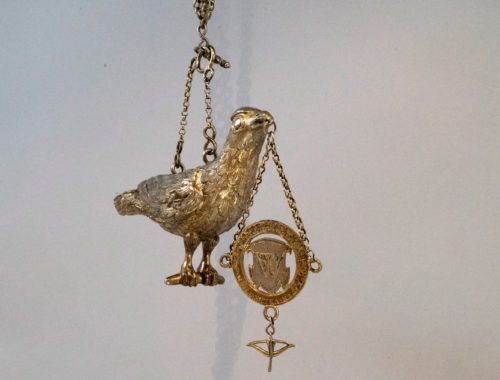Object number :
North Germany, 1598
silver-gilded, chased, cast, chased, punched, engraved, unmarked
Inscription in the center of the shield: monogram “BW”, around it is a ring with inscription: “DE(R?) BURSCHAP. THO. WESTEN. VELDE. THON. ALDENBERGEI HORT DUSSE BIRD THO 1598”
Height: 12 cm, length: 19 cm, weight: 250 gr
Detailed Description
At the “King’s Shoot” of the farming community of Westenfelde, this silver, gold-plated shooting trophy was awarded in 1598. Hanging on a double chain with eyelets, upon which the coat of arms of the marksmen’s guild of Westenfelde is embossed, this Parrot was considered the highest award of the so-called “bird king”.
The stylised Parott clings tautly to a small branch. It hangs balanced – like a mobile – on a double chain. On the beak of the bird is an eyelet from which hangs a chain holding a ring with the inscription “DE(R?) BURSCHAP. THO. WEST. VELDE. THON. ALDENBERGEI HORT DUSSE VOGEL THO 1598”. Below it dangles a crossbow, indicating the weapon to have been used in the sporting contest. The escutcheon shows the monogram BW for the “Burschap von Westenfelde”.
The expression “Burschap” (Latin “Burscarpium”), North German for “peasantry”, is used especially in the region around Hanover. The origin of the bird can be traced back to the village of Westenfeld, Altenberge in the district of Steinfurt, in North Rhine-Westphalia. The coats of arms and medals attached to the beaks of the marksmen’s birds were often so heavy that the birds’ beaks were damaged or broke off completely. Well-preserved marksmen’s birds therefore have a high rarity value. Fortunately, the silver bird, evidenced by an illustration in the Art and Curiosity Dictionary of 1883, has been excellently preserved to this day.
THE “PARROT” AS AN AWARD FOR THE “BIRD KING.
Ernést Bosc’s encyclopedia describes the use of the “Papegai/Papegay” as a prize for a game of skill played by marksmen. The game entailed, a bird made of wood or cardboard being placed on a pole, needing to be hit successfully in order to obtain the longed-for trophy. The game, which was already popular in the 14th century, was intended to motivate shooters to achieve outstanding marksmanship. Cities and rulers donated coveted prizes such as cups and bowls made of silver, coins, medals and sometimes even oxen, in order to be able to fall back on well-trained marksmen at the gun in an emergency. To this day, bird shooting is practised as a sporting competition in many localities.
“PARROTS” ON ROYAL CHAINS
As an award, for the sporting competitions that were already widespread in the 14th century, it had become fashionable from 1500 onwards to attach birds to chains in order to honour the “bird-shooting king” after winning the bird-shooting competition several times. Honour chains like these, also known as king chains, along with plaques, medals, and coins hanging from them, were given as awards to particularly talented shooters.
Pigeons, parrots, swallows, eagles and roosters often served as silver prize birds. Many of the birds are stylised and cannot be clearly identified. A number of silver birds have survived from the period 1500 – 1700, for example in Braunschweig, Duderstadt, Epe and Linz on the Rhine and in the Victoria and Albert Museum in London. Traditionally the royal chains indicated the coat of arms and the name of the shooting guild, in addition, often on plaques the names and dates of the shooting kings. The birds themselves were equipped with inscriptions, rings, crowns, collars and branches over the years, in the case of the Brunswick king’s chains, the regular use for many decades, sometimes centuries, made it necessary to renew the gilding several times, this can also be proven by sources in Brunswick.
PROVENIENCE
Only a happy coincidence – the early passage of the trophy was within the recognised art collection of Monsieur Maxime Ducamp, in the 1880s – allowing such an excellent state of preservation of the object. Its appreciation is evidenced not only by its mention and illustration (!) in an encyclopedia of the 19th century; to the present day – the bird was in the collection J. Kugel Paris until 2008 – the extraordinarily well-preserved shooting trophy thereby impresses the viewer.
LITERATURE
Bosc, Ernést: Dictionnaire de l`art, de la curiosité et du bibelot, Paris 1883, pp. 516 – 518, therein esp. pp. 517f. with illustration and transcription of the inscription (there, 1528 is wrongly given in the dating).
To shooting fraternities and shooting guilds, shooting trophies, “parrots” and royal chains:
Rönz, Andrea: Quellen zur Geschichte der St. Sebastianus Schützenbruderschaft Linz (2014/2019), in: Stadtarchiv Linz am Rhein – Archiv und Stadtgeschichte im Web 2.0, https://archivlinz.hypotheses.org/232
“Duderstadt Rifle Guild, Historical Royal Necklaces,” https://www.sg-duderstadt.de/unsere-tradition-kultur/schuetzenketten/index.html
“Duderstadt Rifle Guild, Rifleman’s Bird and Bird Shooting”, https://www.sg-duderstadt.de/unsere-tradition-kultur/schuetzenvogel-vogelschiessen/index.html
“Schützengilde St. Katharina Epe, Chronicle”, https://www.schuetzengildestkatharina.de/chronik/
“Schützenorden, Schützenschilden, Schützenplaketten, Schützenmedaillen”, exhibition Schützenketten und Kleinodien in Studio 18 Ahlen 1965, http://Schützenketten und Kleinodien (studio-18-ahlen.de)
Spies, Gerd: Fünf Jahrhunderte Braunschweiger Schützen, exhibition Städtisches Museum Braunschweig 1970, including several marksmen’s birds and royal chains
Stierling, Hubert: Von alter Schützen Herrlichkeit, in: Nordelbingen, Beiträge zur Heimatforschung in Schleswig-Holstein, Hamburg und Lübeck, volume 21, Heide in Holstein 1953, p. 31 – 39
Victoria and Albert Museum London: “Archery Prize, Mechelen, Jongh, Jean De, 1770”, https://collections.vam.ac.uk/item/091837/archery-prize-jongh-jean-de/
Victoria and Albert Museum London: “Popinjay, North Brabant, 1500 – 1550”, https://collections.vam.ac.uk/item/0324476/popinjay-unknown/







